The research project describes the ways to effectively handle the different projects and the customers in the hospitality and the tourism sector. The researcher here for the ease of the analysis has taken the case study of the renowned Hilton Group of Hotels and Resorts. The researcher has tries to explain the problems and also provided the recommendations which according to the reasercher are sufficient for the growth of the company’s services. For this purpose the researcher has collected sufficient primary data from with the help of the interviews of the customers who have already experienced their stay in any of the branches of Hilton hotel and the mangers of the hotel.
With the help of the different techniques and methodology the researcher tried to ascertain the results and recommended the solutions accordingly. The researcher in this respect evaluated that the effective use of the factors will help the Hotel to implement its projects both global and national fruitfully. The survey with the customers shows that they are more or less satisfied with the services provided by the Hotel nut there is still a gap in the total management of the service quality hence the management of the hotel needs to rectify that gap to gain the highest position in this sector.
Are you Sacrificing Your Social Life to Finish Your Dissertation Paper?
Take Dissertation Writing Help from us and Submit an Impressive Paper on Time
Conducting this research has been one of the most preferable experiences of my life. It has contributed exceptionally in enhancing my knowledge base and skills of analysis. I was capable of overcoming the challenges that I faced while competing this dissertation. However, all this would not have been possible without the guidance and help of many persons supporting me. First, I would like to thank my supervisor ___________ for constant assistance and guidance throughout the research. Special thanks to my academic guides who shared their knowledge and encouraged me. I would also like thank my friends who provided me moral support and helped in collecting the primary data from various resources. Finally, I would like to thank the organizational personnel who participated in the research survey and shared their valuable insights. The support of all these people gave the strength and courage required for conducting this study.
Thanking You All,
Yours Sincerely
1.1 Introduction
1.2 Research aim
1.3 Research objectives
1.4 Research questions.
1.5 Background of the company: Hilton group of hotels and Resorts
1.6 Rationale of study
2.1 Introduction
2.2 Current Project Management trends in Tourism and Hospitality Sector
2.2.1 Total Quality Management (TQM)
2.2.2 Customer Relationship Management (CRM)
2.2.3 Life time value of customer and its importance
2.2.4 Relation between the TQM, CRM and Customer Loyalty
2.2.5 Grievance Management 12
2.2.6 GAP between Customer Perception and Customer Expectation
2.3 Conceptual Framework
2.4 Summary.
3.1 Introduction
3.2 Method outline
3.3 Research onion
3.4 Research philosophy and its justification
3.5 Research approach and its justification
3.6 Research design and its justification
Are you Sacrificing Your Social Life to Finish Your Dissertation Paper?
3.7 Data collection procedure
3.8 Sampling technique
3.9 Ethical considerations
3.10 Research limitations
3.12 Summary
4.1 Introduction
4.2 Quantitative questions for the customers
4.3 Quantitative questions for the managers
Chapter 5: Conclusion and Recommendations
5.1 Introduction
5.2 Objective Linking
Objective 1: To identify the ways to improve the synchronization between the projects through the involvement of the technology
Objective 2: To analyze the project management issues which are affecting the growth for Hilton Hotels in global market?
Objective 3: To develop a well synchronised project management framework this will help The Hilton Hotels to manage their global projects
5.3 Recommendations
5.4 Future Scope of the Study
References
Appendix
Figure 1: Grievance management 14
Figure 2: Conceptual Framework. 16
Figure 3: Research onion. 18
Figure 4: Types of research philosophy. 19
Figure 5: Steps involved in Deductive approach. 20
Figure 6: Gantt chart 22
Figure 7: Satisfaction level of the customers with Hilton hotel 24
Figure 8: Problem faced by customers in residing at Hilton hotels. 25
Figure 9: Analysis of the service provide by the hotel 26
Figure 10: Analysis of the satisfaction level of the use of modern technologies in Hilton hotels. 27
Figure 11: Analysis of the grievance management of the hotel 28
Figure 12: Use of technology to improve the co ordination between projects and customer delivery 30
Figure 13: Important factors affecting the growth of the projects undertaken by the hotel 31
Figure 14: Effective management of the global projects. 32
Table 1 : Satisfaction level of the customers with Hilton hotel 23
Table 2: Analysis of problem faced by customers in residing at Hilton hotels. 25
Table 3: Analysis of the service provide by the hotel 26
Table 4: Analysis of the satisfaction level of the use of modern technologies in Hilton hotels. 27
Table 5: Analysis of the grievance management of the hotel 28
Table 6 : Use of technology to improve the co ordination between projects and customer delivery 30
Table 7: Important factors affecting the growth of the projects undertaken by the hotel 31
Table 8: Effective management of the global projects. 32
The hospitality and the tourism industry is a growing industry of UK which employs about 9% of the total working population (Zahay, 2009). It is one of the fastest growing economies which comprises of more than one third of the total global economy. The sector had faced a reduction in its revenues during the time of the recession because of the reduction in the purchasing power of the tourists. But according to Lo et al (2010) the industry revived its position in the recent years to recover for the loss it suffered. The Hilton group of hotels founded in the year 1919 aims to provide a fresh environment to the tourists serving over 78 countries across the world (Sen, 2009). It provide comfortable atmosphere for the tourist and thereby maintains a customer loyalty in the sector.
The aim of the research here is to analyse the system of the project management incorporated by the hospitality and the tourism industry of UK. The researcher thereby tries to evaluate the project management system of the renowned Hilton group of hotels to get a clear picture of the whole industry.
- To identify the ways to improve the synchronization between the projects through the involvement of the technology
- To analyze the project management problems which are affecting the growth for Hilton Hotels in global market
- To develop a well synchronised project management framework which will help The Hilton Hotels to manage their global projects
- How the inclusion of the modern day technology can help to improve the project management capabilities for Hilton Hotels?
- How much the project handling problems are affecting the growth for Hilton Hotels worldwide?
- What are the main problems Hilton Hotels are facing in managing the global projects?
- What framework Hilton Hotels can follow to manage their global projects?
Acknowledgement
Originally based in UK, Hilton group of hotels are one of the biggest chains of International hotels which have its branches in more than 78 countries (www.hilton.com, 2014). The main mission of the company is to create an unforgettable experience for the customers in both business and leisure travels so as to retain the customers and create a sense of customer loyalty. The main objectives of the hotel are to enhance the guest experience, improvement of the operational efficiency, protection of the environmental factors and strengthening of the partnerships with other groups (www.hilton.com, 2014).
The main reason for the choice of this topic is to ascertain the ways through which the international tourism and hospitality industry manages its projects. With the rising number of hotels in different parts of the world it has become very important for all the hotels to maintain a standard benchmark in the quality of the services provided by them. Since the number of substitutes is high in this industry hence effective management of the different projects and attraction of the customers are the primary duty of the hotels.
This chapter will focus on establishing the relation between the different academic and proposed theories and with the current industry scenario of the hospitality and tourism sector. With the help of this academic foundation the researcher aims to enhance the quality of research topic. The proposed theories will help the researcher to analyse the situations through which the current industry is passing and will thus help the researcher to derive at a fruitful conclusion.
The project management trends in the tourism and hospitality industry are the factors which the industry should consider for the betterment of the service. Since it is a service industry hence its success depends completely on the effective management of the customers (Kalisch, 2009). The current trends followed by this sector are:
Globalization: According to Bolton and Lemon (2009) the hotel industry for effective management of the projects is trying to globalise their services. Nowadays it is seen that all the hotels are encountering customers from varied parts of the world with varied cultures. Hence it is required by the hotels to globalise their services.
Safety issues: The industry has become vulnerable to the increasing terrorist attacks. Hence according to Jiang et al (2009) the hotels are trying to incorporate disaster management plans and making personal safety as the first priority.
Service: Quality plays an important role in the services provided by the hospitality industry. Kwak and Ibbs (2009) are of the opinion that the degree of satisfaction can be increased by providing a diversified service at a reasonable price. But Soderlund (2009) argues that quality service cannot be provided by all companies. For enhancing the service quality extensive training should be provided to the employees.
Technology: It is the driving force for creation of different opportunities and improving of the customer’s experience. For the smooth running of the business the hotels are now days using the different database systems to store the information about the customers and mange them effectively (Casado, 2009). The online service helps the clients to view the services offered by the hotels and to make the selection accordingly. This not only increases the number of customers for the hotel but also reduces the territorial boundaries.
Table of Contents
According to Anwar and Hamilton (2010) the TQM is the process of creating a climate where the quality of the services and the products are continuously enhanced by employing of different techniques. The key concept based on which the company’s perform the TQM is that the quality of a service or a product is defined by the requirements of the customers. In the hospitality sector the definition of the quality denotes the obtaining of the goods and the services which will satisfy the needs of the customers and also these services should be above their expectation levels. So according to Easton and Jarrell (2010) the concept of quality management is an essential concept in this industry.
Pettersen (2009) are of the opinion that for attaining a successful TQM process the management of the company should try to identify the customer’s needs and accordingly enhance the service or product feature through continuous efforts and different systematic analysis. The TQM concept offers quality in the fields of total quality control, quality circles, provide standard quality, satisfaction of the employees, satisfaction of the guests and also maximisation of the profits.
According to Xie et al (2014) the management of the quality of service on the hospitality industry is very essential. The quality of a service provided may be analysed in two respects namely the perceived service and the actual service. The quality of actual service provided by the hotels can be increased with the help of the various research techniques like incident based methods. But Lee et al (2011) argues that the actual quality of the service may at times be good but still the customers may not be satisfied with the same. This generally occurs due to high expectations of the customer towards a particular service.
According to Murphy (2012) to understand the expectations of the customers the hotels can make use of the different tools like the survey of the satisfaction levels through use of questionnaires, use of the technique mystery guest, analysis of the market situations and also evaluation of the audit reports.
CRM combines all the aspects of the interaction of the company with its customers. According to Dutu and Halmajan (2011) in the present scenario the business of different sectors are facing high level of competition and hence they have to make efforts to survive in the market by creating a competitive advantage in the sector of efficient management of the customers. According to Costa and Buhalis (2012) the service industry should have the knowledge of the special treatment that they should provide to each individual customer. The hospitality industry has adopted the system if CRM because of some rising issues like the complexity in the nature of the customers’ expectations, the deficiency of the technologies, complexities associated with the management of the perishable products and retention of the loyal customers. Atkinson (2009) is of the opinion that there are four parameters to ensure the success of the CRM. They are as follows:
Impact of corporate strategy: The companies implementing CRM should at first identify the corporate strategy and then should give emphasis on the customer centric approach.
List of Figures
Efficient technologies: The technologies thus used in the different departments of the company should be combines to provide a compact data about the successful application of CRM (Badri and Davis, 2010).
Improvement in the partnerships: For a better result of the CRM process the partnerships within the organisation should be improved.
Efficient management of the CRM technique: The management officials who are responsible for the implementation of the CRM should be well knowledgeable about the process and the technologies for applying it. According to Badiru (2011) misuse or partial knowledge about the programme may result in a failure of the project.
According to Chang et al (2010) lifetime value of a customer is the total profit which the company or the industry will derive from the future relationship with the customer. The purpose of conducting the lifetime value assessment is to ascertain the financial value of the customer. Hence if the company is able to determine the value of the customer with whom it is dealing then it would be easier for the company to take the decision as to which customer is important and should be retained in the future. According to Lewis et al (2010) the top two pressures faced buy the hospitality industry are the increased pressure from the emergence of competitors and the availability of less number of loyal customers. It is seen that the introduction of the online reviewing system has helped the customers to instantly book the hotels according to the suitability of their locations and the cheaper price. Kutsch (2010) are of the opinion that although this is a plus point for the customers but it is a drawback for the hotels because the websites may be misleading and the customers in this respect are not paying a visit to the hotel to make a correct judgement. However according to Johnson et al (2011) the branded hotels cannot set lower price levels because of the brand valuation. Hence this creates a problem for them to gets loyal customer base.
Hence the big chain of hotels should try to retain the customers by enhancing their service quality (Kim et al.2010). They should personalise the services that they are providing and in doing so they will create an image in the mind of the customers and they will have a brand recall value of the same. The hotel industries in this respect can also provide seasonal discounts or discounts on the special suits. They can also provide some additional services for the special types of customers. According to Kutsch (2010) these service enhancements will help this sector to retain the customers.
CRM is the basic technique adopted by the customer oriented industries. In other words the CRM method is solely used to identify the needs of the customers and to enhance the service quality in order to provide satisfaction to the customers (https://www.researchgate.net, 2014). TQM is a strategy adopted by the companies to focus on the effective controlling and monitoring of the overall all the process of the organisation to achieve an overall satisfaction level in every respect of the organisation. According to Costa and Buhalis (2012) TQM is the broader aspect of CRM or it can be said that the CRM is a part of the TQM process. The TQM aims at achieving the quality satisfaction in all sections of an organisation the sections of an organisation also concerns its customers. They are a broad base of the total quality management of a company. Irrespective of the fact whether the company is a customer oriented company or not, the management has to maximise the quality of the service or the goods provide to the customers.
List of Tables
According to Kalisch (2009) the total quality of the company can only be maximised when the service provided are also maximised in terms of their quality. Hence the implementation of the CRM technique is essential in this respect. This technique will pay specialised attention to the maximisation of the customers’ service quality and thereby will help the company to achieve its improvement level.
Soderlund (2009) are of the opinion that the implementation of both TQM and CRM is necessary for the achievement of the customer loyalty. The enhancement in the level of the service provided will help the particular company to attract more customers and will eventually help the company o to retain the valuable customers for the purpose of the profitable growth.
The employees are the backbone of any industry and the customers are the base of any industry, hence it is the duty of the industries to check the grievances of both the parties (Pettersen, 2009). There is generally a set of procedures for the effective management of the grievances concerning both the parties. The framework of the organisation should provide the different norms as to how the employers and the mangers should monitor the behaviour of the employees and what benefits should the employees get in their due course of time. According to Kim et al (2010) the different types of grievances faced by the employees of the hospitality industry are namely the increased work pressure, inconvenient work timings, rude behaviours from the customers, lack of respect at the workplace, negligent amount of salary, sexual harassments etc. The companies in the hospitability sector in this respect to reduce the employee turnover rate have introduced various methods to attain to the grievances of the employees (Easton and Jarrell, 2010).
According to Costa and Buhalis (2012) the grievance of the employees can be handled with the effective management of the human resource. The company in this respect should form a committee which will see to the grievances of the employees and will also protect the interest of the employees. Kutsch (2010) are of the opinion that the customers are also having various complaints with the services in the hospitality industry. The industry here needs to recover the service by creating an effective communication process with the customers. For this the companies can create suggestion box system where they can collect the suggestion and the complaints of the customers and handle them accordingly.

According to Badiru (2011) the quality service model is an important model in which helps to define the objectives behind quality management. It is a consumer oriented model and it helps the different service industries to understand the quality of service that is to be provided to the customers. According to this model the consumer’s assessment of the quality of the service will be perceived by a series of gaps in the service process. Atkinson (2009) are of the opinion that it is the duty of the service providers to effectively close these gaps and increase the service quality. These gaps arise because of the difference in the expectations of the customers and the perception of the quality of the service provided to the customers. But Kalisch (2009) argues that it is difficult for the hotel industry to analyse the expectation of the customers because the preferences and the taste of the customers are ever changing.
Chapter 1: Introduction
To understand the perceptions of the customers the industries are using the application of the perceived quality service tool (Easton and Jarrell, 2010). The expected quality of the service by the customers is directly affected by the marketing promotional techniques used by the different companies, the attractive images of the tourism packages of the different companies, the varied number of options along with reasonable and affordable rates, the influence of the word of the mouth of the other customers who have already availed the service and the basic needs and the requirements that the customers have. Dutu and Halmajan (2011) are of the opinion that the main factor which is responsible for the enhancement of the perception of the customers is the reliability of the customers over the particular service. If the customer is able to rely completely on the service and the service provider then the gap between the expectation and the perception can be reduced. (Pettersen (2009) are of the opinion that the higher the gaps the lesser will be the level of satisfaction hence the main motive of the industries should be to reduce the gaps by correct assessment of the problems which the customers are encountering.
According to Kutsch (2010) there can be five different types of gaps as follows:
Gap 1 between consumer expectation and management perception: This arises due to wrong perception of the managers about the customers’ expectations
Gap 2 between perception of the management and the specification of the service quality: This arises when the manger in spite of knowing the customer’s needs do not set the correct service standards or specifications (Atkinson, 2009).
Gap 3 between Specification of the service quality and the service delivered: This arises due to negligence in the delivery of the service by the service provider.
Gap 4 between service delivery and the external factors: This arises when the customers’ expectations are highly influenced by the external factors like the advertisements of the company and when the poor delivery of the service doesn’t fulfil those expectations (Badiru, 2011).
Gap 5 between the expected service and the actual service received: This is the last gap which changes the perception of the customers. It arises when they are not satisfied with the level of the service provided (Easton and Jarrell, 2010).
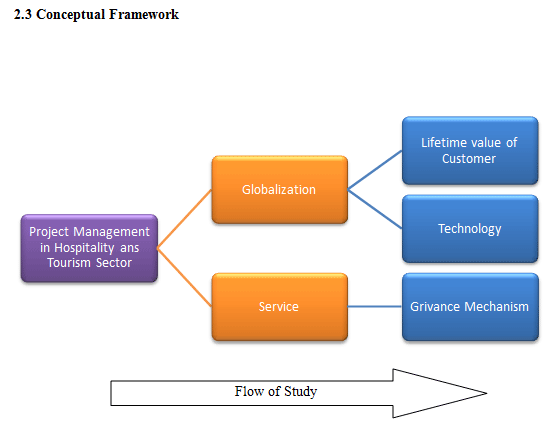
As seen in the particular chapter the researcher has taken ample of time to analyse the different proposed theories and the concepts which the researcher found useful for establishing the aims and the objectives of the research. The evaluation of the different concepts and the terms which defines the ways of achieving the customer satisfaction level in the service industry will help the researcher to analyse the data which will be collected by the researcher for the purpose of the evaluation of the problems of this industry.
This chapter gives insight knowledge about the type of research method which is being followed by the researcher along with the mention of the data collection process and the philosophies and the approaches adopted by the researcher along with proper justification.
Chapter 2: Literature review
The chapter provides detail research techniques to analyse the effective project management issues of the hospitality sector. The positivism philosophy is selected for the acquiring information for the relevant topic. The researcher here is using both primary and he secondary data to arrive at the conclusions and the researcher has decided to incorporate the qualitative and the quantitative technique to compete the research process.
It is the tool used by every researcher to successfully implement the research process. The onion shows the different stages of the process according to their importance and ensures that if the researcher follows the same then the process will be smoothly completed in the due time. The research onion is divided into six stages- philosophies, approaches, strategies, choices, time horizons and finally techniques (Magilvy and Thomas, 2009).

According to Bernard (2011) research philosophy helps in determination of the appropriate manner in which the research work is to be conducted. It determines the mindset of the researcher and contributes to the success of the project. Out of the three philosophies namely the positivism approach, realism approach and the phenomenology approach, the researcher here has selected he positivism approach (Dul and Hak, 2012).
The selection of the positivism philosophy will help the researcher to apply logical explanation in analysing the hidden facts of the project. This philosophy helps the researcher to make a detail observation and extensive collection of the knowledge required for the completion of the project (Harrison and Reilly, 2011).
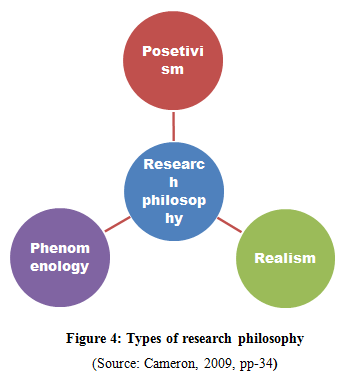
The research approach is basically the determination of the procedure of the research. According to Truscott et al (2010) there are two types of research approach namely inductive and deductive research approach. The researcher here has selected the deductive approach because this approach includes evaluation of the conclusions on the basis of the observations thus made by the researcher. In this case it may be stated that the inductive approach is followed for establishment of some new ideas (Cameron, 2009). But the researcher here is not dealing with establishment of any new theory rather the researcher will derive conclusions from the observations made by him.
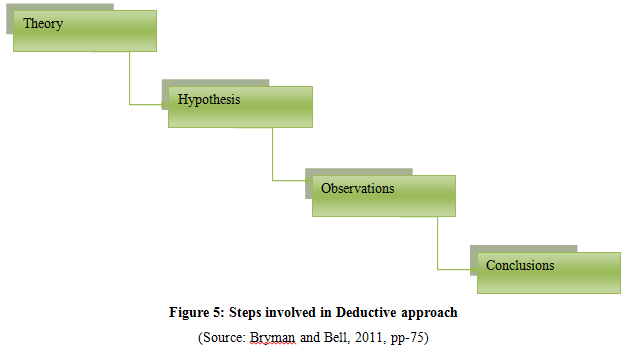
The research design is the blueprint of the research work which determines the aims and the objectives of the research (Onwuegbuzie and Leech, 2009). There are three types of research design namely the Explanatory, Exploratory and descriptive. To continue this research the researcher has selected the explanatory research design because the explanatory research design enable the researcher to explain every factor of the research through detailed explanation which enables the researcher to analyse the research objective from all possible angels so that the outcome of the research becomes very much valid and reliable.
According to Ellis and Levy (2009) the validity and the reliability of the data ensures the positive result of the research. The researcher here will concentrate to collect both the primary and the secondary data. The primary data will provide the real life picture and the secondary data will provide the proper stage for the better understand in of the scenario. The secondary data will be collected through the analysis of the books, academic journals and the published websites (www.newagepublishers.com, 2014). The primary data will be collected through the interview process over the selected sample population which will consist of 40 customers and the 10 managers of the Hilton hotels.
Chapter 3: Research methodology
Sampling is one of the very important factors for the continuation of the research project (Cooper and Schindler, 2010). The researcher will follow both the probability and the non-probability sampling. The researcher will select the customers through the probability sampling to remove any scope of ambiguity within the sample. The researcher will select the managers through the non- probability sampling because it is not possible to take a large number of sample population for the managers.
Bryman and Bell (2011) opined that not only the completion of the project is important for the successful completion of a research project the basic research ethics should be maintained. Data and the sample population majorly contribute in the success of any research project. The researcher will ensure that the data collected from the guest and the managers will not be disclosed under any circumstances (Brannen, 2009). The researcher will ensure that during the data collection process the researcher will not influence any one to get favourable data. This is a completely academic research so for the continuation of this project no monetary transactions will be included.
This research is purely an academic research so there are areas from where the limitations may arise (Denzin and Lincoln, 2011). The hotel authority may not permit the researcher to interview the guests as the majority of the guests who stays in this hotel belong to the high profile class and they love their privacy more than anything else. The managers of this hotel may not entertain the researcher.
3.11 Time horizons
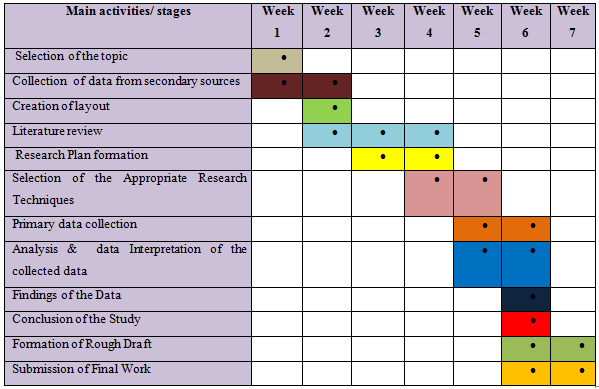
The chapter here deals with the description of the research tools selection which will help the researcher to continue with the research job smoothly. With the help of this chapter the researcher has given the reader a good description of the various tools used and has given the proper justification behind using those tools. The formation of the blueprint of the research structure and the assessment of the time taken will help the researcher to complete the research work on time.
In this chapter the researcher will produce the analysed results of the collected data from the customers and the managers of the Hilton hotel. The researcher for the better analysis of the collected data applied the quantitative data analysis approach. To gather required data from the sample population the researcher has framed quantitative questionnaires.
|
Q1: Are you satisfied with the services of the Hilton hotel?
|
Options |
Number of Respondents |
Total Number of Respondents |
Percentage of Response |
|
Very satisfied |
12 |
40 |
30% |
|
Satisfied |
14 |
40 |
35 % |
|
Neutral |
5 |
40 |
12.5 % |
|
Dissatisfaction |
6 |
40 |
15% |
|
Very dissatisfied |
3 |
40 |
7.5 % |
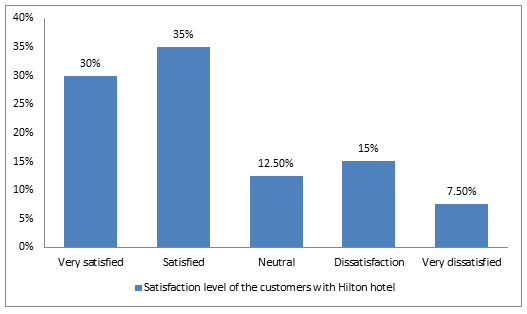
Figure 7: Satisfaction level of the customers with Hilton hotel
This question was asked to the customers to understand the satisfaction level of the customers with the services of the Hilton hotel. Out of the total 40 customer’s majority of the customers that is around 30% of the customers are very happy and very satisfied with the services of the hotel. So it can be said that the company can expect more than 30% of the customers to be loyal towards the hotel and they would also recommend the same to their friends. 35 % of the customers are of the opinion that they are happy and just satisfied with the services of the hotel. From this it can be analyzed that this percentage of customers will probably give a second visit to the hotel. Out of the sample size only 22 % of the population is not happy with the services hence to gain the market share the hotel needs to reduce this percentage to zero percent.
Chapter 4: Data Interpretation and Data Analysis
Q2: Is there any kind of problem which you have faced while residing in Hilton Hotels anywhere?
|
Options |
Number of Respondents |
Total number of Respondents |
Percentage of Response |
|
Yes |
5 |
40 |
12.50 % |
|
Neutral |
15 |
40 |
37.50 % |
|
No |
20 |
40 |
50 % |
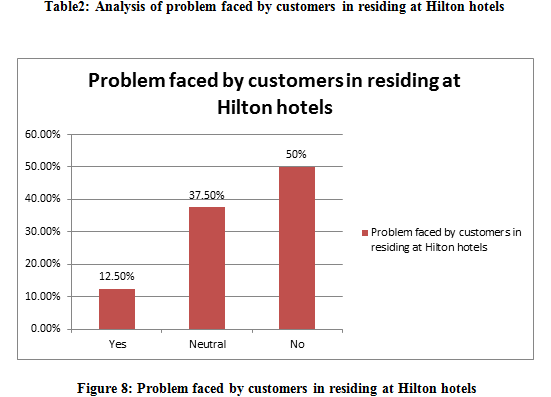
This question was asked to the customers to analyse whether the rate of problems faced by the customers with residing in the Hilton hotels and resorts. The data collected from the answer of this question will help the researcher to understand varying level of the satisfaction which is seen in the previous question. Out of total 40 customer 37.50 % of customers were unresponsive on being asked this question. Hence it was difficult to analyse whether they were satisfied or not. Around 50% of the total sample size confirmed that they were satisfied with the services because they did not encounter any problem during their stay in the hotel. A very least percentage of customers around 12.50 % opined that they had faced certain problems while their stay at the hotel.
Q3: Do you agree that the hotel provides the best in class service keeping the customer’s preferences in mind?
|
Options |
Number of Respondents |
Total number of Respondents |
Percentage of Response |
|
Strongly Agree |
25 |
40 |
62.50% |
|
Agree |
10 |
40 |
25.00% |
|
Neutral |
3 |
40 |
7.50% |
|
Disagree |
1 |
40 |
2.50% |
|
Strongly Disagree |
1 |
40 |
2.50% |
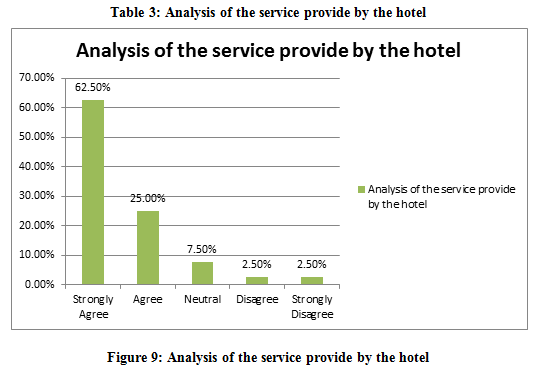
On being asked whether the Hilton group of hotels provides the best class service or not majority of the customers wagered to the point. They are of the opinion that the services provided by the hotel at the different parts of the world are very good and are the best compared to those provided by the other hotels of the same nature. Around 62.50% of the customers are strongly agreeing to the point and around 25% is agreeing to the point hence from the analysis of the answers given by the customers in this question the researcher can reach o a conclusion that the quality of the services provided by the hotel is high and the gap between the customers’ expectations and the customers perception in getting reduced.
Q4: Do you agree that the use of modern technologies by Hilton Hotels enhanced your experience?
|
Options |
Number of Respondents |
Total number of Respondents |
Percentage of Response |
|
Strongly Agree |
22 |
40 |
55% |
|
Agree |
9 |
40 |
22.50 % |
|
Neutral |
2 |
40 |
5 % |
|
Disagree |
5 |
40 |
12.50 % |
|
Strongly Disagree |
2 |
40 |
5% |
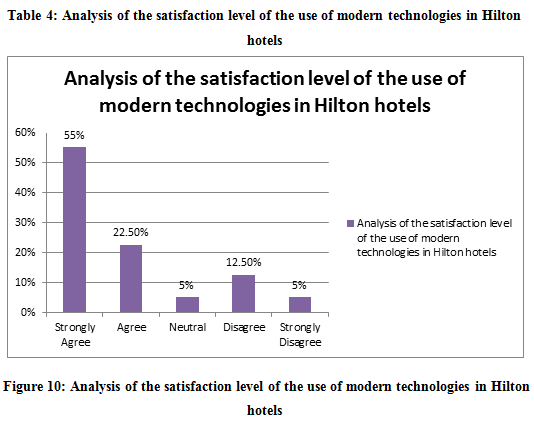
This question helped the researcher to understand the advantage which the hotel is getting from the incorporation of the different new technologies for enhancing the experience of the customers. The customers here who have already stay in the hotel are of the opinion that the use of the modern infrastructure, the use of the high class technology to provide prompt room service and the use of the technologies to record and mange the customers data base are some of the helpful tools used by the hotel. Around 55 % of the customers strongly agree that the use of these technologies have enhanced their experience. A total of about 20 % of the customers are of the opinion that the use of the technologies didn’t make any change in the experience. 5% of the customers were neutral because they were not aware of the technological changes and were not in a position to comment on that.
Q5: Do you agree that the Hotel manages the grievances and other issues very professionally and provides value for customer?
|
Options |
Number of Respondents |
Total number of Respondents |
Percentage of Response |
|
Strongly Agree |
18 |
40 |
45.00% |
|
Agree |
13 |
40 |
32.50 % |
|
Neutral |
4 |
40 |
10.00% |
|
Disagree |
3 |
40 |
7.50% |
|
Strongly Disagree |
2 |
40 |
5.00% |
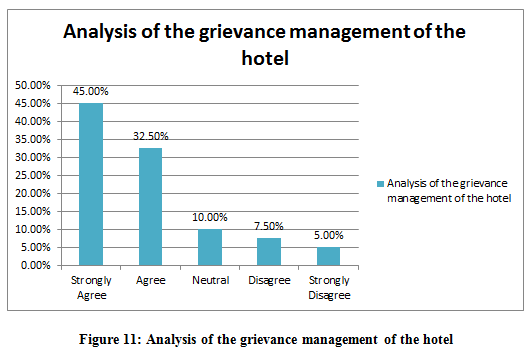
Management of the grievances and the correct attention towards the solving of the complaints are the two major objectives of any hospitality sector. Hence the researcher asked this question to get a clear view on the satisfaction level of the grievance managed by the hotel. On being asked about the opinion of the agreement or disagreement on the factor 45 % of the customers were of the opinion that they strongly agree with the researcher and 32.50% of the customers said that they generally agree with the researcher. 10 ‘5 of the customers were neutral over the matter they are not sure about the fact and are hence reluctant to give their opinions. Around 12.5% of the customers are of the opinion that they disagree with the fact stated by the researcher.
|
Chapter 5: Conclusion and Recommendations
Q1: Do you agree that technology can improve the coordination between the projects and customer delivery?
|
Options |
Number of Respondents |
Total number of Respondents |
Percentage of Response |
|
Strongly Agree |
4 |
10 |
40% |
|
Agree |
2 |
10 |
20% |
|
Neutral |
2 |
10 |
20% |
|
Disagree |
1 |
10 |
10% |
|
Strongly Disagree |
1 |
10 |
10% |
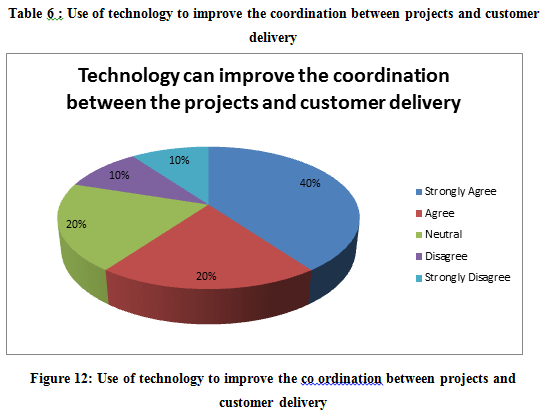
This question was asked to the mangers of the Hilton hotel to understand their view about the implementation of the modern and improved technologies on the management of the different projects. On being asked this question 40% of the mangers were of the opinion that they strongly agree o the point mentioned by the researcher that the incorporation of the technology for the management of the project has enhanced the quality of the services provided to the customers. 20 % of the mangers were neutral about their opinion because they didn’t find it fit to comment on the workings of their own company. Whereas 10% each were of the opinion that they either strongly disagree or just disagree with the fact of the researcher. Among them some are of the opinion that the extensive uses of technologies have increased the costs of the hotel.
Q2: According to you what can be the most important factors that will affect the growth of projects in the Hotel?
|
Options |
Number of Respondents |
Total number of Respondents |
Percentage of Response |
|
Time |
2 |
10 |
20% |
|
Length of the Projects |
1 |
10 |
10% |
|
Resource Allocation for the projects |
3 |
10 |
30% |
|
Resource requirements for the projects |
2 |
10 |
20% |
|
Demographic positions of the projects |
2 |
10 |
20% |

The researcher asked this question to analyse the factors affecting the growth of the project undertaken by the hotel. The factors mentioned here by the mangers have helped the researcher to get an idea about the reasons contributing to the growth of the projects in the hotel. The mangers here have mentioned the most important factors which they consider for the effective completion of the project. Out of the five different factors around 30% of the managers are of the opinion that Resource allocation is an important factor which contributes to the effective growth of the projects. The other important factors like the time of the project, resource requirements and the demographic positions of the project are considered as important by 20% of the mangers in each case. Only 10% of the managers are of the opinion that the length of the project is also an important factor.
Q3: How you think the global projects can be managed more professionally without hampering the guest’s experiences?
|
Options |
Number of Respondents |
Total number of Respondents |
Percentage of Response |
|
Proper resource allocation |
3 |
10 |
30% |
|
Through the use of Technology |
5 |
10 |
50% |
|
Through maintaining the time scale |
2 |
10 |
20% |
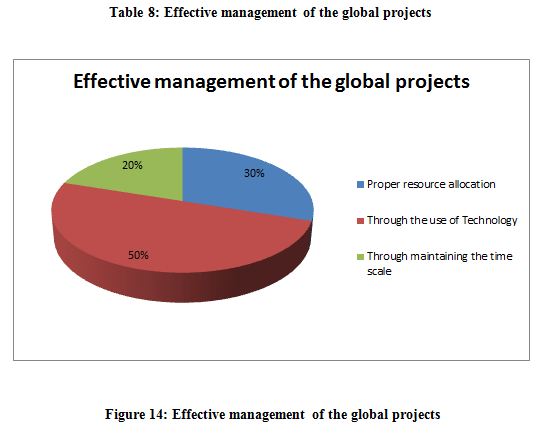
The researcher here asked this question to the mangers to understand the effective ways in which the hotel can manage its global projects without hampering the customer values. Here 50% of the mangers are of the opinion that the company on this respect should use the technology for the successful implementation of the global projects and this will not reduce the quality of the services provided to the customers. 30% of the managers are of the opinion that the hotel management should consider effective allocation of the resources in respect of each project. This will help the company to retain its customer service and will also help the hotel to procure the necessary financial support as required to complete the project. Only 20% of the mangers are of the opinion that the hotel should concentrate on the time scale required for the completion of the project.
Chapter 5: Conclusion and Recommendations
In this chapter the researcher have produced the results of the data analysis and linked the results with the prefixed objectives. The objective linking has been done so that the relevance of the research can be produced very systematically. In the later part of this chapter the researcher will put focus on the scope of the future research. Based on the analysed outcomes the researcher will produce some of the probable recommendations for the betterment of the project management and hotel operations for the Hilton Hotels.
The objective here is to understand the ways in which the hotel can improve the synchronization between the projects through the implementation of the technologies. The researcher here has linked this objective in the questionnaire in questions 4 and 1 in the customer’s analysis and question 1 in the analysis of the managers. The questions 1 and 4 show the satisfaction level of the customers and the satisfaction which the customers derive from the effective use of the technologies by the hotels. This has helped the researcher to understand the purpose and the advantage which he hotel is deriving from the extensive use of the technologies. Since the result is positive hence it can be said that the use of technology is enhancing the customer’s satisfaction levels and is also contributing into effective management of the project. The mangers are also on being asked the question is seen to strongly agree to the fact that the use of the technology will enhance not only the customer’s satisfaction levels but also create a link between the projects and the customer’s service.
The objective of the researcher here is to analyze the factors which will affect the growth of the project. The researcher here has linked the questions number 2 of the customer’s questionnaire and also question number 2 of the manager’s questionnaire. The objective here is to identify the factors which contribute to the effective growth of the different projects undertaken by the hotel. In this respect the researcher tried to analyse whether the customers are facing any problem during their stay at the hotel because this will help the researcher to understand the effectiveness of the projects and will help the researcher to understand that the factors as cited by the mangers actually contribute to the effective management of the projects. The question asked to the mangers has helped the researcher to understand the factors which the company thinks are important for establishing the objective.
The objective of the researcher here is to find the factors that will help in the development of the global projects of the hotel. For this the researcher has incorporated the questions 5 and 3 of the customer’s questionnaire and question 3 of the mangers questionnaire. The researcher in this respect by asking the question about providing the beast class services to the customers was trying to analyse the effectiveness of the global projects thus undertaken by hotel. The global projects in this respect includes the effective management of the different customers from all over the world for managing the global customers the hotel needs to undertake different CRM projects which would suit the needs of the customers .In this respect for further clarification on the workings of the hotel the researcher asked the fifth question to the customers which indicated that the hotel is effectively managing the grievances of the customers. The mangers in this respect are trying to analyse the factors which will affect the success of the global projects.
The researcher after the analysis of the primary data has reached certain conclusions and according to the data collected is able to provide certain recommendations for the same. The recommendations are as follows:
- The management of the hotel needs to pay more attention to the procurement of the resources required for the implementation of the projects. For doing this they need to first plan out in details the quantity and the quality of each of the resource required for the effective completion of the project. This will reduce their failure rates of the project.
- The customer satisfaction can be increased with the help of more enhanced technologies and the hotel should concentrate on lowering the cost so that the services of the hotel can be afforded by all segments of customers.
- The hotel also needs to increase its customer loyalty base. It s seen that although majority of the customers are very satisfied with the service quality but still there are many customers who are just satisfied and it is to be noted that percentage of customers will not be loyal towards the hotel.
- For increasing the customer loyalty level of Hilton group, the management of the company should improve their CRM process and should try to minimise the gap between the customers’ expectation and perception.
The project here is based on the assessment of the project management by the hospitality sectors and for the purpose of easy assessment the researcher here has selected the Hilton group of hotels as the case study. However this topic can also be analysed from the customer’s point of view and be made to determine the problems faced by the customers. The researcher alternatively could have also selected effective management of the customers and the creation of the brand loyalty. Since the customers are the major base of the hospitality hence an extensive study on the problems, expectations and the perceptions of the customers can be conducted in future projects. If in future the topic is revised and the assessments of the customers are done then it will help the Hilton group of hotels to get a clear picture about the changes they need to make in their existing service structure.
To export a reference to this article please select a referencing stye below:
My Assignment Help. (2015). Effective Project Management In The Hospitality And Tourism Industry: A Case Study Of Hilton Group Of Hotels And Resorts Essay.. Retrieved from https://myassignmenthelp.com/free-samples/dissertation-sample-project-management-in-international-hospitality-and-tourism-sector.
"Effective Project Management In The Hospitality And Tourism Industry: A Case Study Of Hilton Group Of Hotels And Resorts Essay.." My Assignment Help, 2015, https://myassignmenthelp.com/free-samples/dissertation-sample-project-management-in-international-hospitality-and-tourism-sector.
My Assignment Help (2015) Effective Project Management In The Hospitality And Tourism Industry: A Case Study Of Hilton Group Of Hotels And Resorts Essay. [Online]. Available from: https://myassignmenthelp.com/free-samples/dissertation-sample-project-management-in-international-hospitality-and-tourism-sector
[Accessed 30 May 2025].
My Assignment Help. 'Effective Project Management In The Hospitality And Tourism Industry: A Case Study Of Hilton Group Of Hotels And Resorts Essay.' (My Assignment Help, 2015) <https://myassignmenthelp.com/free-samples/dissertation-sample-project-management-in-international-hospitality-and-tourism-sector> accessed 30 May 2025.
My Assignment Help. Effective Project Management In The Hospitality And Tourism Industry: A Case Study Of Hilton Group Of Hotels And Resorts Essay. [Internet]. My Assignment Help. 2015 [cited 30 May 2025]. Available from: https://myassignmenthelp.com/free-samples/dissertation-sample-project-management-in-international-hospitality-and-tourism-sector.
